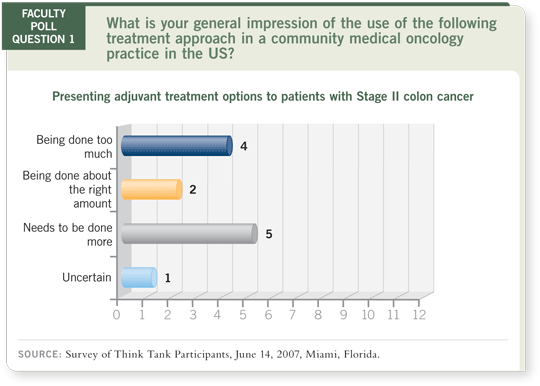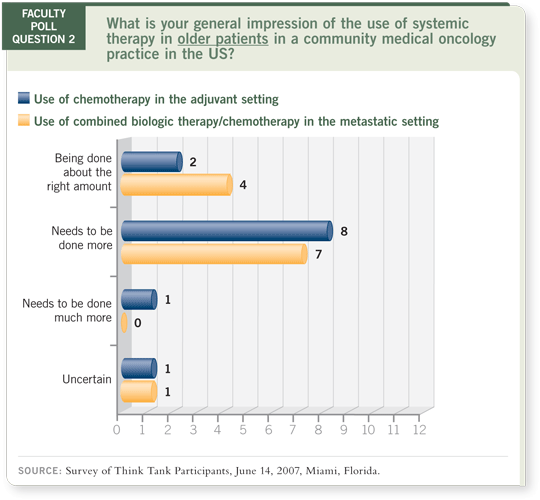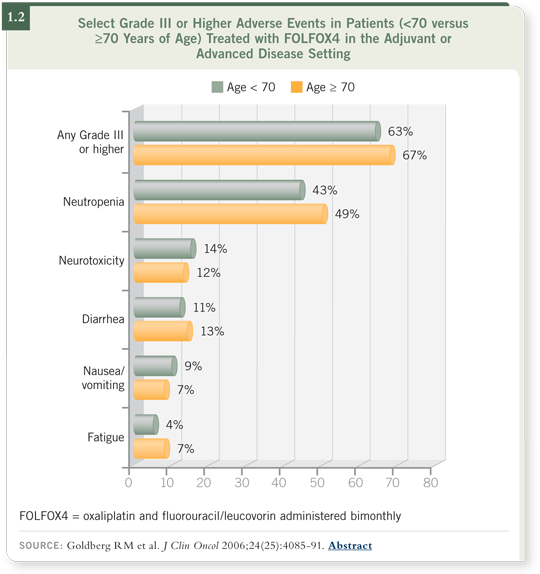

Select Excerpts from the Discussion
Tracks 30-37
 DR LOVE:
DR LOVE: What are your thoughts about the update of the MOSAIC trial
presented at ASCO 2007 (1.1)?
 DR WOLMARK: Frankly, I was a little perturbed that the presentation (de
Gramont 2007) emphasized stage subsets and ascribed p-values to them. The
one justification for ascribing the
DR WOLMARK: Frankly, I was a little perturbed that the presentation (de
Gramont 2007) emphasized stage subsets and ascribed p-values to them. The
one justification for ascribing the
p-value to the analysis of patients with Stage
III disease is that, post hoc, the FDA conducted their own unplanned subset
analysis and limited the indication to patients with Stage III disease. I believe
that from a biologic standpoint, we have no reason to think that patients with
Stage II disease are a unique subset relative to their responsiveness to adjuvant
therapy. They’re simply at a lower risk for recurrence.
The irksome part from my perspective is not that all patients with Stage II disease should be treated — it’s that all patients with Stage II disease should be
apprised of the benefit of adjuvant chemotherapy.

 DR LOVE: Neal, what’s your take on the Stage II debate?
DR LOVE: Neal, what’s your take on the Stage II debate?
 DR MEROPOL: The challenges are in defining which patients are at the
greatest risk of relapse from the group of patients with Stage II disease and in
selecting those patients for adjuvant therapy because their potential for benefit
is greater.
DR MEROPOL: The challenges are in defining which patients are at the
greatest risk of relapse from the group of patients with Stage II disease and in
selecting those patients for adjuvant therapy because their potential for benefit
is greater.
Patients have different values with regard to the tradeoffs of the potential
benefits and side effects. This requires a discussion about the option of
adjuvant therapy — the potential hazards, which are well defined, and the
potential benefits, which are less well defined for any individual.
 DR HOCHSTER: Every patient with Stage II cancer would benefit from
seeing a medical oncologist. Even if they decide against adjuvant therapy, they
reap other benefits, such as discussions about the risk of colorectal cancer for
relatives and how they can be screened. Patients also need to know how their
health-related issues for the next 25 years will change as a result of the cancer,
particularly in terms of future screening so that if they’re the one patient in five
who develops a recurrence, we can capture it when it’s likely to be curative.
DR HOCHSTER: Every patient with Stage II cancer would benefit from
seeing a medical oncologist. Even if they decide against adjuvant therapy, they
reap other benefits, such as discussions about the risk of colorectal cancer for
relatives and how they can be screened. Patients also need to know how their
health-related issues for the next 25 years will change as a result of the cancer,
particularly in terms of future screening so that if they’re the one patient in five
who develops a recurrence, we can capture it when it’s likely to be curative.
 DR LOVE: Bob, when should surgeons be sending patients with Stage II
disease to a medical oncologist?
DR LOVE: Bob, when should surgeons be sending patients with Stage II
disease to a medical oncologist?

 DR WOLFF: For sure, those patients who had an inadequate lymph node
assessment should be referred. I also believe patients with a lower risk of recurrence
should be referred. The people you might exclude are patients who are
frail or those who experienced a lot of postoperative complications.
DR WOLFF: For sure, those patients who had an inadequate lymph node
assessment should be referred. I also believe patients with a lower risk of recurrence
should be referred. The people you might exclude are patients who are
frail or those who experienced a lot of postoperative complications.
 DR HURWITZ: I would recommend a referral for most patients. If they’re well
enough to undergo surgery, they’re well enough to undergo a discussion about
the risks and benefits of chemotherapy and how those risks can be modified or
dealt with during treatment.
DR HURWITZ: I would recommend a referral for most patients. If they’re well
enough to undergo surgery, they’re well enough to undergo a discussion about
the risks and benefits of chemotherapy and how those risks can be modified or
dealt with during treatment.
Tracks 1-3
 DR LOVE:
DR LOVE: What about older patients, particularly octogenarians?
 DR GOLDBERG: I’m currently treating a woman for whom we decided not to
use adjuvant therapy at 82 years of age, although she had 15 positive nodes. I’m
now treating her with the same regimen in the advanced disease setting that
I would have recommended in the adjuvant setting, and I’m wondering, had I treated her earlier, whether I could have delayed or eliminated a recurrence.
Probably not, but she’s receiving the same therapy, only she’s two years older.
DR GOLDBERG: I’m currently treating a woman for whom we decided not to
use adjuvant therapy at 82 years of age, although she had 15 positive nodes. I’m
now treating her with the same regimen in the advanced disease setting that
I would have recommended in the adjuvant setting, and I’m wondering, had I treated her earlier, whether I could have delayed or eliminated a recurrence.
Probably not, but she’s receiving the same therapy, only she’s two years older.

I am interested in trying to open oncologists’ minds to considering more
aggressive therapy for patients for whom they might not have considered it
before (1.2). Often in my practice, if I’m worried that somebody might not
tolerate the treatment, I’ll use 5-FU/leucovorin for the first cycle. If the
patient comes back and is doing well, then I’ll add oxaliplatin.
Select Publication

